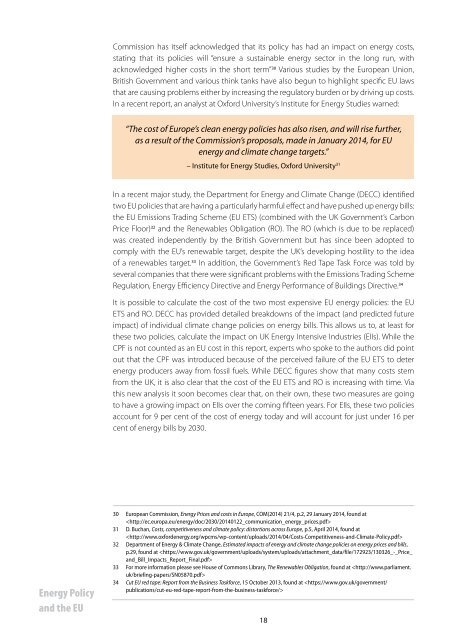BFBEnergyPaper
BFBEnergyPaper
BFBEnergyPaper
Create successful ePaper yourself
Turn your PDF publications into a flip-book with our unique Google optimized e-Paper software.
Commission has itself acknowledged that its policy has had an impact on energy costs,stating that its policies will “ensure a sustainable energy sector in the long run, withacknowledged higher costs in the short term” 30 Various studies by the European Union,British Government and various think tanks have also begun to highlight specific EU lawsthat are causing problems either by increasing the regulatory burden or by driving up costs.In a recent report, an analyst at Oxford University’s Institute for Energy Studies warned:“The cost of Europe’s clean energy policies has also risen, and will rise further,as a result of the Commission’s proposals, made in January 2014, for EUenergy and climate change targets.”– Institute for Energy Studies, Oxford University 31In a recent major study, the Department for Energy and Climate Change (DECC) identifiedtwo EU policies that are having a particularly harmful effect and have pushed up energy bills:the EU Emissions Trading Scheme (EU ETS) (combined with the UK Government’s CarbonPrice Floor) 32 and the Renewables Obligation (RO). The RO (which is due to be replaced)was created independently by the British Government but has since been adopted tocomply with the EU’s renewable target, despite the UK’s developing hostility to the ideaof a renewables target. 33 In addition, the Government’s Red Tape Task Force was told byseveral companies that there were significant problems with the Emissions Trading SchemeRegulation, Energy Efficiency Directive and Energy Performance of Buildings Directive. 34It is possible to calculate the cost of the two most expensive EU energy policies: the EUETS and RO. DECC has provided detailed breakdowns of the impact (and predicted futureimpact) of individual climate change policies on energy bills. This allows us to, at least forthese two policies, calculate the impact on UK Energy Intensive Industries (EIIs). While theCPF is not counted as an EU cost in this report, experts who spoke to the authors did pointout that the CPF was introduced because of the perceived failure of the EU ETS to deterenergy producers away from fossil fuels. While DECC figures show that many costs stemfrom the UK, it is also clear that the cost of the EU ETS and RO is increasing with time. Viathis new analysis it soon becomes clear that, on their own, these two measures are goingto have a growing impact on EIIs over the coming fifteen years. For EIIs, these two policiesaccount for 9 per cent of the cost of energy today and will account for just under 16 percent of energy bills by 2030.Energy Policyand the EU30 European Commission, Energy Prices and costs in Europe, COM(2014) 21/4, p.2, 29 January 2014, found at31 D. Buchan, Costs, competitiveness and climate policy: distortions across Europe, p.5, April 2014, found at32 Department of Energy & Climate Change, Estimated impacts of energy and climate change policies on energy prices and bills,p.29, found at 33 For more information please see House of Commons Library, The Renewables Obligation, found at 34 Cut EU red tape: Report from the Business Taskforce, 15 October 2013, found at 18


